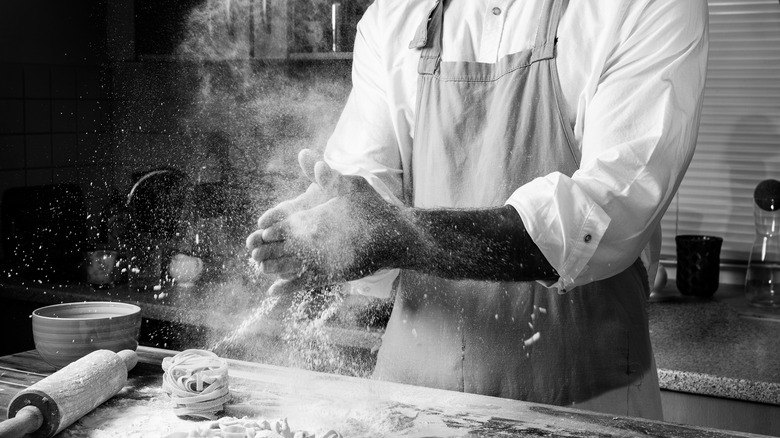Kitchen Aprons Are Evolving Into Kitchen Jumpsuits For Winter Cooking
While the world has seen a number of things that feel timeless, from fashion trends to new-age gadgets, everything has its day. This is especially true of what we wear on the street, but the sentiment applies to the equipment in our kitchens too. French presses and pour-overs made way for automated coffee machines, and today 36% of Americans use air fryers over their ovens according to The New York Times. And now, even a long-beloved kitchen garment is at stake — the apron.
While aprons have long been an integral part of the kitchen uniform both in the home and in the professional space, there is always a more modern spin on a classic, and aprons are no exception. So, what's threatening to overtake this long-beloved part of the kitchen experience? The jumpsuit. Practically, the jumpsuit makes sense. It provides coverage for your entire body, and most aprons lack the fabric to protect you from every potential spill. But is pulling on a utility jumpsuit a bit much for your time in the kitchen? For some types of cooking, we think not.
A short history of the humble apron
While the jumpsuit is a somewhat recent invention (it sprouted up in 1919 as a uniform for factory workers), the apron has a rich history. According to Alsco Uniforms, the first record of an apron comes from paintings in the 14th century. While it has always been worn as a protective garment, it was depicted in art as a statement piece among the wealthy. Many women in the Middle Ages sported decorative aprons with gems and jewels. Aside from the upper classes, peasants wore aprons solely for the same practical reason we do today — to protect their clothes from damage.
Following the early days, the apron evolved across professions. In the 19th century, what we now know as the chef's uniform made its first appearance at a restaurant in London.
While aprons remain a fixture in the professional world, they became less prominent in American households starting in the 1960s. Half-aprons especially had become less popular as the times of "glorified housework" came to an end. While the apron is not as common in households today as it once was, for many it remains a must-have piece of protective equipment in the kitchen for safety, health, and even aesthetic reasons. As the kitchen apron continues to evolve, slowly we're coming into the era of the kitchen jumpsuit.
Move over apron, it's the jumpsuit's time to shine
While an apron has long been a classic piece of kitchen wear, consider a jumpsuit the next time you pull out the pans. According to chef Wilder Davies, it's the perfect choice for when you're taking on a particularly arduous recipe, via Epicurious. Jumpsuits were literally made to protect factory workers in some of the messiest jobs, so why not wear them while facing the inevitable floury mess of baking? More than a traditional bib apron, a jumpsuit offers all the coverage you need with no worries about loose ties or exposed skin. You can have the same protection offered by a four-piece chef's uniform by pulling on just one garment instead. Plus, it's the perfect choice for winter cooking. (It's easy to keep warm in a full-body garment).
In light of all these sentiments, work clothes brand Tilit has started rolling out kitchen jumpsuits that are literally meant to be worn in lieu of an apron (per its website). Already the brand's invention has been making waves, appearing in major publications like Vogue, and some home chefs that have tried the suit are raving about it on social media. So while you might not need a jumpsuit to tackle a simple spaghetti dinner, it's a great choice for taking on some of the messiest dishes you can make.


